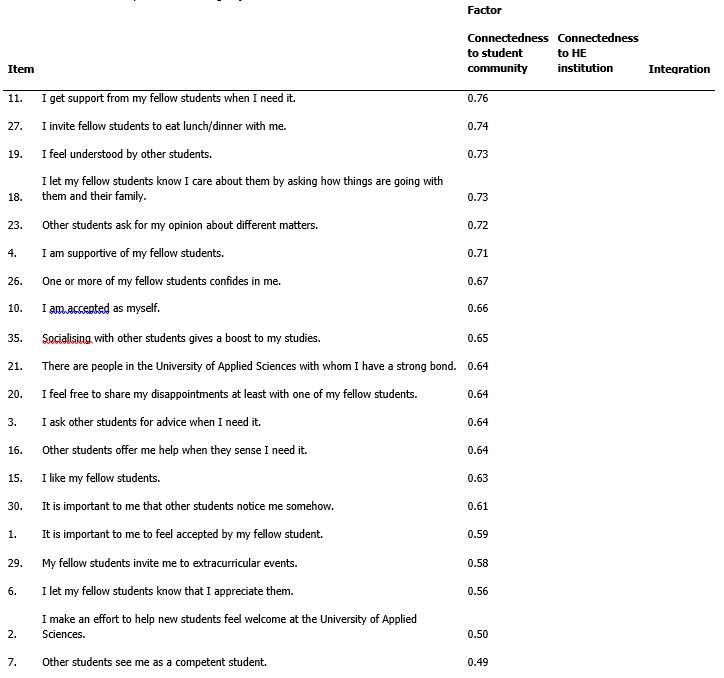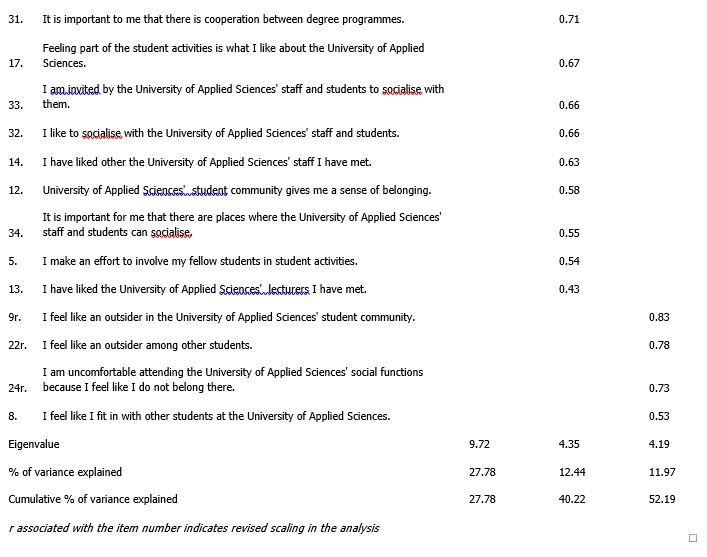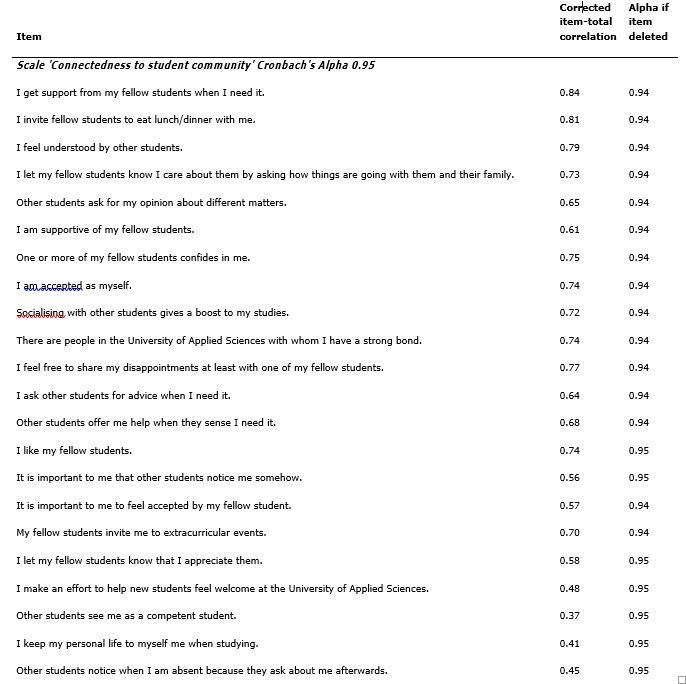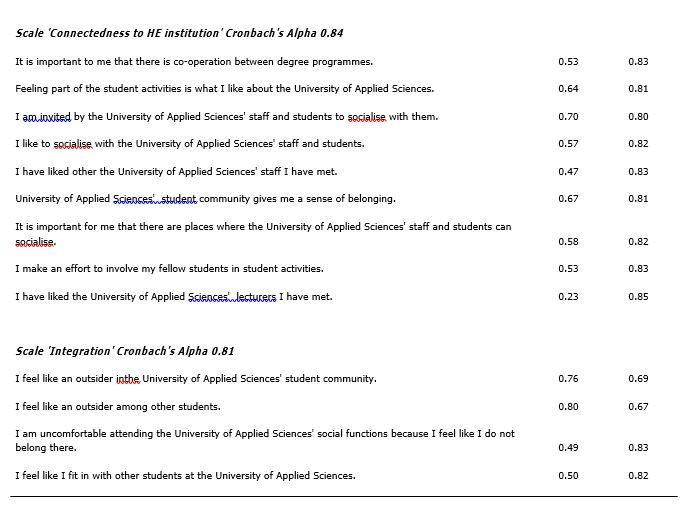Introduction
The starting point of this pilot study and the larger project around it was the concern about student wellbeing in higher education institutions (HEIs). In a recently published study the students of Finnish universities of applied sciences felt that the strongest factors associated with their ability to study were their personal resources and their social study environment (Lavikainen 2010: 97–108). Many studies report that students feel less satisfied with their lives than the general population (Vaez, Kristenson, & Laflamme 2004; Kjeldstadli et al. 2006).
Student wellbeing can be examined from the viewpoints of general life-satisfaction (Krokstadt 2002), self-esteem (Mellor, Cummins, Karlinski & Storer 2003), stress (Lopez et al. 2001) and coping (Vitaliano et al. 1985). However, the belongingness dimension seems to be increasingly important one when we look at the higher education institutes nowadays. The concept ‘belongingness’ has been used more than before since the 1960s (e.g. Osterman 2000; Levett-Jones et al. 2007). It has been defined from the various viewpoints in social sciences and psychology. According to Hagerty et al. (1992), ‘sense of belonging is the experience of personal involvement in a system or environment so that persons feel themselves to be an integral part of that system or environment’. Baumeister and Leary (1995) and Somers (1999) define belongingness ‘as the need to be, and the perception of being involved with others at different interpersonal levels, which contributes to one’s sense of connectedness (being part of, being accepted, fitting in) and esteem while providing reciprocal acceptance, caring and valuing each other.
Belongingness, connectedness and integration or lack of them, are related to many wellbeing factors of students: self-esteem, burdensomeness, sleep, depression, risk of suicides (Lee 2002; Armstrong et al. 2009; Wong et al. 2011). They are also associated with student retention, academic attitudes, motives and progress which are professional, scientific and economic indicators of success for individual students and for higher education institutions (Tinto 1975; Osterman 2000; Rosenthal et al. 2007; Allen et al. 2008). According to Tinto (1975) student drop out is associated with the students’ degree of academic integration, and social integration. This is why higher education institutions need instruments to follow up students’ sense of belongingness.
Konrath et al. (2011) found that empathy amongst American college students has been declining sharply since 2000 and so has the capacity to take another persons’ perspective into consideration. School shootings are the most serious indicator of separation and malaise. According to Newman (2004), the school shooters are far from being ”loners” but rather ”joiners” whose attempts at social integration have failed. School bullying may lead to a negative view of students’ peers and schoolmates. In the long run, the effects include an increased risk of depression and a negative attitude toward other young adults. (Ministry of Justice, Finland 2009). Lack of integration, belongingness or connectedness characterise often these youngsters. The extent of school shootings indicate that something must be done to improve the wellbeing of the students.
This study is a part of a larger research and development project called ‘Promoting student
wellbeing in Second Life’. The purpose of the project was to promote the availability of student wellbeing services in real world and virtual world. It was financed by the Finnish Ministry of Social Affairs and Health. In previous phases of the project, a qualitative study was conducted involving the students and staff of one large Finnish University of Applied sciences (UAS) in order to find means to promote communal wellbeing and a sense of belongingness. On the basis of those suggestions, an action model was set up for communal meeting spaces that had been established. Also virtual student wellbeing services were constructed and studied their usefulness.
In order to promote belongingness in higher education institutes, we must have instruments to measure it. The aim of this part of the study was to formulate a scale measuring belongingness in higher education institutions.
Materials and methods
Data collection
This pilot study was conducted during spring 2011. Helsinki Metropolia University of Applied Sciences is a multidisciplinary higher education institute having about 16,000 students with 67 degree programmes, 14 of them being taught in English. An invitation to take part in the study via a web-based questionnaire was placed in an internal information portal of University of Applied Sciences. Identical paper questionnaires with boxes for returning them were also placed in seven communal meeting places created in the previous phase of this project. The questionnaires and hard copy versions of them were available in the web for three weeks. The data received from the web based questionnaires was converted to SPSS PASW 18 program directly after the end of the data collection period. The boxes were collected back by the project group members and coded to the same SPSS matrix as the web based data by the first author of this article. This program was also used for the analysis.
Instrument
The questionnaire began with eleven background questions, four of them about sosiodemographic issues (age, gender, marital status and number of children or other dependents), three about studies (degree programme of the respondent, years of studies and basic education), and four about taking part in student or other activities.
There are many scales measuring belongingness (e.g. Mehrabian 1994; Leary et al. 2007). The 35- item instrument was developed on the basis of the Levett-Jones Belongingness Scale – Clinical Placement Experience (Levett-Jones et al. 2009), which has its ground on the work of Baumeister and Leary (1995) and Somers (1999). This scale was chosen on the basis of instrument development because the Levett-Jones (2009) instrument has also been developed in the higher education context in an institution respective to universities of applied sciences in Finland. The construct validity and consistency reliability of the Levett-Jones (2009) scale were high. The authors believe that belongingness is multifaceted concept that needs to be examined from several viewpoints. The benefit of the scale chosen (Levett-Jones et al. 2009) is that it is multidimensional. The permission to use and modify the scale was received from the creator of the scale in written.
The Levett-Jones et al. (2009) BES–CPE –instrument had 34 items which formed three factors: Esteem subscale (Cronbach’s alpha 0.92) comprising statements being in held esteem by one’s work colleagues, Connectedness subscale (Cronbach’s alpha 0.82) included statements concerned with interpersonal connections, and items included in Efficacy subscale (Cronbach’s alpha 0.80) were about efficacious behaviours undertaken to enhance one’s experience of belongingness. Four of the original items (Q6, Q11, Q15 and Q27) were left out of the questionnaire because they were specific to clinical replacement. Five new items about cooperation and meeting places were added because in the qualitative study by Jenze (2010), which was also part of the same larger study, it was found out that in the higher education context, communal meeting places are very important in order to gain a feeling of belongingness. BES–CPE items Q12 and Q22r, which were excluded from the factor analysis in the testing by Levett-Jones et al. (2009), were included in our questionnaire, but not item Q6. In the instrument the phrase ’clinical replacement’ was substituted with ’University of Applied Sciences’ or the name of it, or ’student community’. The word ’colleagues’ was replaced with the words ’fellow students’ or ’student mates’. Considering the amount of customized and revised items, it can be stated that in this study a new instrument having its grounds in the theoretical structure in the work of Levett-Jones et al. (2009) was formulated.
The instrument was delivered in Finnish and English languages. The customization and first version of the translation was made by the Finnish language project group members who all have good skills in English language. The accuracy of the translation was reviewed by a translator who is both native English and Finnish language speaker. The questionnaire applied five-point Likert-scale. The choices were 1 = never true, 2 = rarely true, 3 = sometimes true, 4 = often true and 5 = always true.
Analysis
The psychometric properties of the instrument were tested in the same way as in the study of Levett-Jones et al. (2009). Principal component analysis with varimax rotation and Kaiser Normalization was performed. The number of factors was restricted to three and Cronbach’s alphas were calculated in order to determine internal consistency of the scales.
Permission for the study was asked from and granted by the vice rector of the University of Applied Sciences. A letter explaining the purpose, financier, voluntary of responding, executors and time of responding was enclosed to the electronic as well as to the paper format questionnaires.
Results
Background variables
Although the questionnaire was available for all the students of the University of Applied Sciences (n=16 000), only 57 responses were received. These represented all the faculties of the UAS: Business school, Civil engineering and building services, Culture and creative industries, Health care and nursing, School of information and communication technology, Industrial engineering, and Welfare and human functioning. The mean age of the respondents was 24 years, with 37% of them married or living in a registered relationship, and there were students from all the semesters of the three and a half years that completing a degree takes. Most of them (75%) had college-level training as basic education, and 60% of them belonged to some real-life community and the same proportion of them to some virtual community.
Psychometric testing
Principal component analysis with varimax rotation and Kaiser Normalization was performed for all the 35 variables of the belongingness scale. Eight components with eigenvalues greater than one were extracted accounting 73.44% of the variance. However, this factor structure did not fit into the theory of the instrument because the first factor comprised most of the variables and the remaining seven factors consisted of one to three items. Factor solutions with five to three factors were run, and out of those the three-factor solution fitted best to the theory of belongingness in the context of higher education institutions. This three-component solution accounted for 52.12% of the higher education institutions students’ sense of belongingness.
The variables stemming from the original scale of Levett-Jones et al. (2009) and the new items created for this study loaded to the factors quite in a different way than in the study of Levett-Jones et al. (2009). For that reason they were renamed. Items loading to the first factor (n=22) were about feeling connected to other students and being part of student community. The first factor accounted for 27.78% of the variance. The items loading to the second factor (n=9) described feeling part of, and belonging to the UAS as higher education institution: importance of cooperation between the degree programmes, taking part to common activities and about the relation to the UAS staff. This factor accounted for 12.44% of the variance. The third factor having four items was about the integration to the student community and higher education institution. It explained 11.97% of the variance. (Table 1)



Cronbach’s Alpha of the first factor ‘Connectedness to the student community’ was 0.95 and item– factor correlations varied between 0.37 (weakest) and 0.84 (strongest). However, leaving any statement out of the scale would not have given higher Alpha to the scale. Scale ‘Connectedness to higher education institution’ received Cronbach’s Alpha 0.84. Item–scale correlations were between 0.23 and 0.70. Leaving out the item ‘I have liked the University of Applied Sciences’ lecturers I have met’ would have given Alpha size of 0.85. The variable was left on the scale because of its importance from the viewpoint of content. The last factor ‘Integration’ received Cronbach’s Alpha 0.81 with item scale variation between 0.49 and 0.80. Leaving the last two items out would have resulted a higher Alpha. The scale was given the name Belongingness in Higher education institutions BES-HE (Table 2)


Belongingness in the higher education institute
In the University of Applied Sciences where the study was made the students gave highest scores to Connectedness to student community dimension of belongingness (mean 3.92), scale Integration mean score was 3.82 and Connectedness to higher education institute 3.48. There was no difference between genders in the sense of belongingness but all the dimension of if had mild inverse correlation with age (0.33 to 0.43).
Discussion
Limitations of the study
The weakest point of the study is the low response rate of the study. Only 57 students answered the questionnaire although there were about 16,000 students in the UAS in question. Although the sample size was small, the respondents represented all the faculties of the UAS. However since the number of respondents was so low, there may be some selection in the sample e.g. students that are most interested in student wellbeing and social issues may have responded. This may have caused some bias to the responses favouring more positive views about the belongingness in the University of Applied Sciences in question.
The data collection was performed as a part of a larger study and comprised only a part of it. The questionnaire as an entity was too long and the marketing of the study could also have been better. However, this was a pilot study and the number of answers received was enough for running validity and reliability tests. Johanson and Brooks (2010) suggest that 30 representative participants from the population of interest is a reasonable minimum recommendation for a pilot study where the purpose is preliminary survey or scale development. The study was performed in just one UAS of Finland, which poses a limitation of geographic generalization. However, being the largest and multidisciplinary UAS in Finland, students all over the country and also from other countries apply for and study in this UAS. Because of the small response rate the results are only indicative need validation with larger and more geographically representative sample. It should also be culturally validated.
Subscales
The BES–HE items loaded to the three factors quite differently than in the validation study of BES– CPE instrument by Levett-Jones et al. (2009), which was made in the context of clinical placement. To the first factor loaded about equal proportion of items from each three original subscales of BES– CPE plus one of the four new statements. However, although the factor structure looked different compared to the BES–CPE scale, it was quite logical when thinking about the context of BES–HE instrument. In the context of higher education social connectedness to individual students is one dimension of belongingness, and commitment to educational institution another (e.g. Allen et al. 2008). The student may feel connected to the fellow students but not connected or committed to the higher education institution or vice versa. To the third factor were loaded four statements which indicate integration to the student community and to the UAS as a higher education institution. In the lives of UAS students, integration is one of the most important developmental tasks especially during the first year of study but also for the students of all the semesters. Like Hagerty et al. (1992) state, integration or ‘experience of personal involvement in a system or environment’ is one central dimension of belongingness. This is why the last factor was given the name Integration.
All the dimensions of belongingness are important but also some different meaning for the higher education students may be found. If we think about individual students’ mental health and general wellbeing the subscales ‘Connectedness to student community’ and ‘Integration’ are the most important. If students feel respected, accepted and supported by other students and is involved in the student community, communicating freely with fellow students, they are better equipped to withstand many threats of student life such as lack of self-esteem in the face of failures, depression, stress and burdensomeness (Lee 2002; Armstrong et al. 2009; Wong et al. 2011). If the student does not feel connected to the student community, it may lead to adverse behaviour as may be read e.g. in the reports about school massacres (Ministry of Justice, Finland 2009). The subscale ‘Connectedness to HE institution’ which comprised items about cooperation between different degree programmes and staff may have more to do with the education success indicators. If the student feels at home in the higher education institution, gets along with the staff, feels that he is supported enough by the institution, this has a positive impact on the retention and progress of the studies (Tinto 1975; Rosenthal et al. 2007; Allen et al. 2008).
Conclusions
As a result of this pilot study, Belongingness in Higher education institutions scale was formed. It comprises three subscales totalling 35 items. Supported by theories of the topic (e.g. Tinto 1975; Rosenthal et al. 2007; Allen et al. 2008) and on the basis of the results of this study the authors suggest that the subscales ‘Connectedness to student community’ and the subscale ‘Integration’ are associated with student wellbeing. They also suggest that the subscale ‘Connectedness to higher education institution’ is associated with success indicators of higher education institutions.
Authors
1st and corresponding author: RT, PhD, Principal Lecturer Eija Metsälä, eija.metsala@metropolia.fi Coordinator, Learning centre for evidence-based practice, Helsinki Metropolia University of Applied Sciences, Health care and nursing
2nd author: RT., MSc., Senior Advisor Eija Heiskanen
3nd author: B. Soc. Sci., Wellbeing Advisor Maarika Kortelainen
[vc_tta_accordion active_section=”0″ no_fill=”true” el_class=”lahteet”][vc_tta_section title=”References” tab_id=”1458134585005-b3f22396-5506″]
Allen, J., Robbins, S.B. & Casillas, A. 2008. Third-year college retention and transfer: Effects of academic performance, motivation, and social connectedness. Research in Higher Education, 49 (7), 647–664.
Armstrong, S. & Oomen-Early, J. 2009. Social connectedness, self-esteem, and depression symptomatology among collegiate athletes versus nonathletes. Journal of American College Health, 57(5), 521–526.
Baumeister, R. & Leary, M. 1995. The need to belong: Desire for interpersonal attachments as a fundamental human motivation. Psychological Bulletin, 117(3), 497–529.
Hagerty, B., Lynch-Sauer, J., Patusky, K., Bouwserna, M. & Collier, P. 1992. Sense of Belonging: A vital mental health concept. Archives of the Psychiatry Nursing, 3, 172–177.
Jenzte, M. 2010. There is no worse thing than to be left alone. Developing communal wellbeing in Metropolia University of Applied Sciences (in Finnish language with English abstract) Unpublished Master thesis in Degree programme of Development and Leadership in Health Care and Social services.
Johanson, G.A. & Brooks, G. P. 2010. Initial Scale Development: Sample Size for Pilot Studies.
Educational and Psychological Measurement 70(3), 394–400.
Kjeldstadli, K., Tyssen, R., Finset,A., Hem, E., Gude, T. Gronvold, N.T., et al. 2006. Life satisfaction and resilience in medical school – a six-year longitudinal, nationwide and comparative study. BioMed Central Medical Education, 6:48. http://www.biomedcentral.com/content/pdf/1472-6920-6- 48.pdf (Accessed 22.12.2011)
Konrath, S. H. 2011. Changes in dispositional empathy in American college students over time: A meta-analysis. Personality and Social Psychology Review, 15, 180–198.
Krokstad, S., Johnsen, R. & Westin, S. 2002. Social determinants of disability pension: a 10-year follow-up of 62 000 people in a Norwegian county population. International journal of Epidemiology, 31, 1183–1191.
Lavikainen, E. 2010. Opiskelijan ammattikorkeakoulu 2010. Tutkimus ammattikorkeakoulu- opiskelijoiden koulutuspoluista, koulutuksen laadusta ja opiskelukyvystä. (With English abstract. Students’ University of Applied Sciences 2010. A study about the UAS’s students’ routes of learning, quality and capacity of learning). Opiskelijajärjestöjen tutkimussäätiö 35/2010.
Leary, M. R., Kelly, K. M., Cottrell, C. A. & Schreindorfer, L. S. 2007. Individual differences in the need to belong: Mapping the nomological network. Unpublished manuscript, Duke University.
Lee, R. M., Keough, K. A. & Sexton, J. D. 2002. Social connectedness, social appraisal, and perceived stress in college women and men. Journal of Counseling & Development, 80(3), 355–361.
Levett-Jones, T., Lathlean, J., Higgins, I., & McMillan, M. 2009. Development and psychometric testing of the Belongingness Scale–Clinical Placement Experience: An international comparative study. Collegian, 16, 153–162.
Levett-Jones, T., Lathlean, J., Maguire, J. & McMillan, M. 2007. Belongingness: A critique of the concept and implications for the nursing education. Nurse Education Today, 27(3), 210–218.
Lopez, F. G., Mauricio, A. M., Gormley, B., Simko, T., & Berger, E. 2001. Adult attachment orientations and college student distress: The mediating role of problem coping styles. Journal of Counseling and Development, 79(4), 459–465.
Mehrabian, A. (1994). Evidence bearing on the Affiliative Tendency (MAFF) and Sensitivity to Rejection (MSR) scales. Current Psychology, 13, 97–116.
Ministry of Justice, Finland. 2009. Jokela school shooting on 7 November 2007. Report of the Investigation Commission. Publication 2009:1.
Newman, K., Fox, C., Harding, D., Mehta, J. & Roth W. 2004. Rampage: The Social Roots of School Shootings. New York: Basic Books.
Osterman, K. F. 2000. Students’ need for belonging in the school community. Review of Educational Research, 70, 323–367.
Rosenthal, D. A., Russell, J., &Thomson, G. 2007. Social connectedness among international students at an Australian university, Social Indicators Research 84 (1), 71–82.
Somers, M. 1999. Development and preliminary validation of a measure of belongingness. PhD, Psychology thesis, Temple University, Philadelphia, USA.
Tinto,V. 1975. Dropout from Higher Education: A Theoretical Synthesis of Recent Research Review of Educational Research 45, 89–125.
Vitaliano, P.P., Russo, J., Carr, J.E., Maiuro, R.D., & Becker, J. 1985. The Ways of Coping Checklist – Revision and Psychometric Properties. Multivariate Behavioral Research, 20, 3–26.
Wong, Y. J., Koo, K., Tran, K. K., Chiu, Y.-C. & Mok, Y. 2011. Asian American College Students’ Suicide Ideation: A Mixed-Methods Study. Journal of Counseling Psychology, 58(2), 197–209.
[/vc_tta_section][/vc_tta_accordion]



